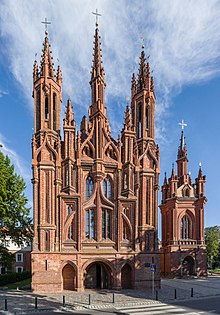Church of St. Anne, Vilnius
| St. Anne's Church Šv. Onos bažnyčia | |
|---|---|
 Façade of Saint Anne's | |
| Religion | |
| Affiliation | Roman Catholic |
| District | Old Town |
| Year consecrated | 1500 |
| Location | |
| Location | Vilnius, Lithuania |
| Geographic coordinates | 54°40′59″N 25°17′36″E / 54.68306°N 25.29333°E |
| Architecture | |
| Architect(s) | Michael Enkinger or Benedikt Rejt |
| Type | Church |
| Style | Late Gothic and Brick Gothic |
| Completed | 1500 |
| Specifications | |
| Direction of façade | West |
| Materials | clay bricks |
| Website | |
| onosbaznycia.lt | |
St. Anne's Church (Template:Lang-lt) is a Roman Catholic church in Vilnius' Old Town, on the right bank of the Vilnia River. It is a prominent example of both Flamboyant Gothic and Brick Gothic styles. St. Anne's is a prominent landmark in the Old Town of Vilnius that enabled the district to be included in the list of UNESCO World Heritage sites.[1] And it is one of the most interesting examples of Gothic architecture in Lithuania.
History

The first church at this site, constructed of wood, was built for Anna, Grand Duchess of Lithuania, the first wife of Vytautas the Great. Originally intended for the use of Catholic Germans and other visiting Catholics, it was destroyed by a fire in 1419. The present brick church was constructed on the initiative of the King of Poland and Grand Duke of Lithuania Alexander I Jagiellon[2] in 1495–1500; the exterior of the church has remained almost unchanged since then. A reconstruction of the church, funded by Mikołaj "the Black" Radziwiłł and Jerzy Radziwiłł, was carried out following severe fire damage, in 1582. Abraomas Kulvietis preached in the church between 1538 and 1541. In 1747, the church underwent a repair under supervision of Johann Christoph Glaubitz. In 1762, side arches of the main portal were hidden in order to strengthen the support for the facade.
According to a well-known legend, Emperor Napoleon, after seeing the church during the Franco-Russian War in 1812, expressed a wish to carry the church home with him to Paris 'in the palm of his hand'. The church was renovated in 1902–1909 when the side arches were uncovered and the walls were strengthened with iron and again in 1960–1970 when the towers in bad shape were restored. On August 23, 1987 the Lithuanian Freedom League held a rally in a square near the church and the monument of Adam Mickiewicz to protest the ongoing Soviet occupation, which was broken up by the militia.[3] Most recent reconstruction followed in 2009: the roofing was replaced, facade elements were reinforced and long-missing side spires were rebuilt.
Architecture

The design of the church building is attributed to either Michael Enkinger, the architect of a church of the same name in Warsaw, or to Benedikt Rejt. However, neither of the attributions is attested by written sources. St. Anne's Church is part of an ensemble, comprising the much larger Gothic Church of St. Francis and Bernadine, as well as a monastery.
A novel approach to bricks as a construction material was employed in the church's construction.[4] The main façade, designed in the Flamboyant Gothic style, is its most striking feature. Traditional Gothic elements and shapes were used in unique ways; Gothic arches are framed by rectangular elements dominating a symmetrical and proportionate façade, creating an impression of dynamism. According to Lithuanian architect and art historian Vladas Drėma, patterns from the Pillars of Gediminas are echoed in the church's façade.
The church has one nave and two towers. It was built using 33 different kinds of clay bricks and painted in red. The interior is decorated in the Baroque style, as is its altar. The imitative neo-Gothic bell tower, constructed in the 1870s to Chagin's designs, stands nearby.
References
- ^ UNESCO World Heritage: Lithuanian masterpieces. Vilnius Historic Center
- ^ Lietuvos dailės muziejus. Taikomosios dailės muziejus. Aleksandro jubiliejui skirta paroda
- ^ Lituanus Quarterly, Vol. 35, No. 1 - Spring 1989 by Asta Banionis
- ^ Lietuvos architektūros istorija. I dalis. Jonas Minkevičius. Vilnius Mokslas 1988 p. 148
